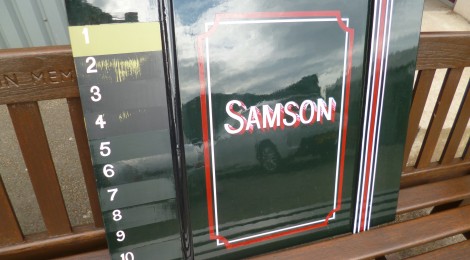
Samson’s lining…
When discussing Samson’s livery, as has been covered in this blog previously with the recording of the application of the paintwork to the bunkers, it should be remembered that we have some source for the scheme applied in the single photograph that exists. This reveals some but not all details of the livery, and of course cannot tell us the colour. Being of 1874 vintage, I selected the ‘dark green’ (or ‘invisible green’ if you are of a Cambrian Railways persuasion) as an appropriate colour, and then studied the lining visible in the photograph to see if this could provide the information needed for detailing the livery of the locomotive.
Below: A reminder of the photograph and Samson’s appearance in c1874
What is clear is that there are two panels on each side of the bunkers, the boiler bands are lined and that the smokebox (which we can safely presume is black) is a different colour to the rest of the locomotive. Whether the panels have a border colour (usually black) is not clear, and what colour the lines are is also not known – again we can presume white or yellow/straw. Images of the similar locomotives ‘Hops’ and ‘Malt’ (supplied to Guinness in Dublin) show panel lines with the concave corner style – so there is some variety in the finish and style applied at the Poole Foundry.
With this in mind, and after a few test panels, I decided to apply a contemporary (to its construction) style of lining, but without panel borders. The reason for this is that a) it is our Samson, not the original so need not slavishly copy what we are not sure of! And b) the borders when trialled looked overly heavy and gave a clumsy appearance. I therefore went for the light colour panel lines, but with a darker shade (maroon in this case) set behind this to create interest and add what I think is a very classy appearance. The boiler bands are dark black, with white lining per the photograph and a maroon centre line to relieve the width. The photo of the final test panel has appeared here before:
This panel is to scale – 1:1 and so can be used as a reference for spacing and width etc. The name itself will be simplified and the white lines on the boiler band sample will be much finer. The maroon contrasts nicely with the white (actually an off-white) and so, with all of this practised and tried, and with Dave and I agreeing it looked the part, I finally made a start this week on applying the lining to the bunkers.
Below: The glossy finish of the green has been scotched back to give a key to the surface, then lining tape (actually that green tape butchers seal bags with) is laid out on pre-marked (with chalk) measurements. The corner radius are added using a compass and pencil, then the tape is cut back as required to leave the appropriate gaps. Thus the straight lines are masked and the corners are free-hand but within pencil guidelines.
Below: With the paint applied (the quickest part of the process!) and the tape removed (the worst part – I really don’t enjoy it as I always seem to mark the surface in some way during the process, not to mention having curled lengths of tape stuck everywhere!), the maroon lining is readily apparent. Next up, mask up the white lines in readiness for their application.
Below: Masking the white took quite some time, and in application, crossing the maroon coloured lines also has to be avoided.
Below: The white lining really sets off the maroon. Here both have been further scotched back ahead of final corrections and varnishing.
Below: Cutting back any mistakes/seepage of the white lining in progress.
Below: … and after varnishing. Time consuming, far from perfect, but rather satisfying! After this photo was taken, the top beading was painted black and the bunker interiors and rears were also painted black (these areas being hidden when the bunkers are installed).
Next week I will have completed the bunkers and these can be temporarily fitted onto the footplate. Meanwhile we are chasing hard the outstanding items for the boiler as the project is now well and truly held up by the lack of these, which in some cases are six months overdue.




















Recent Comments